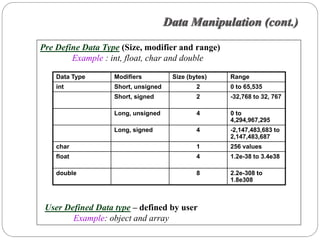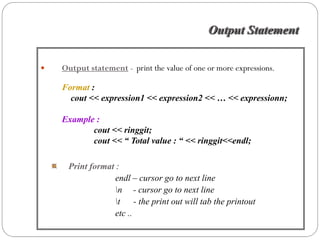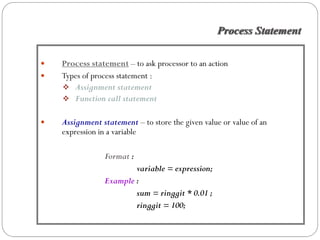Chapter 2 basic element of programming
- 1. Chapter 2 : Basic Element of Programming Language and Sequential Structure
- 2. Lecture Outline Basic Element of Computer Program - General Overview Data Manipulation - Standard data type (int, float, double, char, char[ ]) - Variable Computer Statement - Statement (constant, identifier) - Input/output statement - Arithmetic expression - Assignment concept
- 3. Basic Element of Computer Program Problem Solving using Computer Instruction/Steps 2 Data Input /output Comp. Statements Variable •Data type •Predefine/user define 2 3 4 •Identifier Sequence Selection Iteration •Size •Range •Lifespan •Scope •Independent •Method Functions 5 Procedural Programming vs Comp. Program Object-oriented Programming 6
- 4. Data Manipulation Types of data : 1. Input data – key in by the user (need to solve the problem) 2. Output data – process by the program and display to the user 3. Temporary data – used by the program in the process of obtaining the output data. Data is presented by a variable in a computer program. Variable is a location in the computer’s memory where a value can be stored for use by a program. Elements of the variable : Data Type (Pre Defined / User Defined) Lifespan – How long will the variable exist? Scope –Where can the variable being used? Identifier – Rules in using identifier
- 5. Data Manipulation (cont.) Pre Define Data Type (Size, modifier and range) Example : int, float, char and double Data Type Modifiers Size (bytes) Range int Short, unsigned 2 0 to 65,535 Short, signed 2 -32,768 to 32, 767 Long, unsigned 4 0 to 4,294,967,295 Long, signed 4 -2,147,483,683 to 2,147,483,687 char 1 256 values float 4 1.2e-38 to 3.4e38 double 8 2.2e-308 to 1.8e308 User Defined Data type – defined by user Example: object and array
- 6. Computer Statement Program is a list of instruction that represented by the computer statement. Language element than can be used in constructing high-level language programming form computer statement is called as Token. 6 types of token in C++ programming language : Reserved word Identifier Constant String Literal Punctuation Operator
- 7. Computer Statement (cont.) Type of Token Description Example Reserved Word that has a special meaning to compiler main( ), int, word strcpy Must be typed in the correct location Must be spell correctly (lower case letter) Must be used in the right context Name which is used in a computer program Identifier Other than reserved word Salary, SUM, Mainly to name variables and function PRO_10 Rules : consists of letters A..Z, a..z, 0..9, and _ 1st character must be a letter Case sensitive length : < 32 character, recommended 3 – 8 characters Meaningful name
- 8. Computer Statement (cont.) Type of Token Description Example Constants Item with a fixed value (not be changed in any statement) Literal Constant – value typed directly, int pie = 3.142 wherever it is needed Symbolic Constant – represented by a #define max 10.9 name using a preprocessor directive of const int size = 5 keyword const String Literals Sequence of character surrounded by “ n The minimum double quotation marks value is :” String literals may contain printable characters as a, n.
- 9. Computer Statement (cont.) Type of Token Description Example Punctuator Separators in C++ [ ], ( ), ;, *, # To limit the various syntactical units in programming language Result in computation or action when +, -, *, <>, != Operator applied to variables or other elements in an expression Operator act on operand Unary operator – operator that require one A++, C— operand Total = sum + salary Binary operator – operator that require two cout << (grade > 60 ? operand “ Passed” : “Failed”) Trenary operator – operator that required 3 operand (conditional operator (?:)
- 10. Computer Statement (cont.) Several token will form a Statement. Statement is an instructions to the computer. Computer statement is a specification of an action to be executed by the computer. It is cause the processor to do something. Example : An input statement will input value and placed it to a variable An output statement will print message or result to the user on the computer screen Compound statement is a list of statement enclosed in braces { } that can contain declaration and any type of computer statement.
- 11. Computer Statement (cont.) Types of computer statement Input statement Process statement Output statement Input statement – read the value for one or more variable from the input/user. Format : Pre Defined data type variable cin >> variable1 >> variable2 …. >>variablen; Example : cin>> first >> middle >> last;
- 12. Input Statement Input statement for user defined data type variable Example: array – use getline command string name; char name[20]; Format : // I) use the string data type getline (cin, variable_name) or // II) user know the maximum number of characters will be used cin .getline (variable_name, number_of_characters); Example getline(cin, name) cin.getline(name,20)
- 13. Output Statement Output statement - print the value of one or more expressions. Format : cout << expression1 << expression2 << … << expressionn; Example : cout << ringgit; cout << “ Total value : “ << ringgit<<endl; Print format : endl – cursor go to next line n - cursor go to next line t - the print out will tab the printout etc ..
- 14. Process Statement Process statement – to ask processor to an action Types of process statement : Assignment statement Function call statement Assignment statement – to store the given value or value of an expression in a variable Format : variable = expression; Example : sum = ringgit * 0.01 ; ringgit = 100;
- 15. Assignment statement Assignment statement also can use to the user defined data type such as array of character (string copy – strcpy) Purpose – to copy the content from one string variable to other string variable (and make sure the size of the variable are same) Format: strcpy (new_variable_name,old_variable_name) Example: char old[20], new[20]; strcpy (new, old)
- 16. Function Call statement Function call statement- used to execute the statement in a particular function. Purpose : The result of calling a function and supplying the values for the function parameters. Format : function_name( expression1, expression2,… expressionn); Example: cout << calculatepower( ); // with output statement cout<<pow ( z+y, n); / /with parameter value =sqrt(x); total = calculate ( x, y ); // with assignment statement
- 17. Expression Concepts Programmers should know how to construct the expression and how to get the value. The expression should syntactically correct and meaningful combination of operators and operand. Type of expression Regular expression Arithmetic expression Logical Expression (discuss in chapter 3) Regular expression – describing numbers and denotes any digit between 0 – 9. Example : x = 20;
- 18. Arithmetic Expression Arithmetic expression – using arithmetic operator such as +, -, / etc Example : sum = no1 + no2 total = (no1 – 10) + ( no3 – 20) C++ Arithmetic Algebraic expression C++ expression Operation Operator Addition + F+5 F+5 Subtraction - P-C P-C Multiplication x BxM P*M Division / X / Y or X ÷ Y X/Y Modulus % R mod S R%S Modulus - operator must applied to integer only give the remainder of the integer division
- 19. Arithmetic Expression (cont.) Precedence of arithmetic operators Operator Operation Order of evaluation () Parentheses Evaluated first, left to right *, /, or % Multiplication Evaluated last, if there are Division several, left to right. Modulus + or - Addition Evaluated last, if there are Subtraction several, left to right.
- 20. Sequential Structure Sequence structure – the computer executes C++ statements one after the other in order in which they are written. Sequential Structure Input Statement Process Statement Output Statement Assignment Function Call statement Statement


![Lecture Outline
Basic Element of Computer Program
- General Overview
Data Manipulation
- Standard data type (int, float, double, char, char[ ])
- Variable
Computer Statement
- Statement (constant, identifier)
- Input/output statement
- Arithmetic expression
- Assignment concept](https://image.slidesharecdn.com/chapter2-basicelementofprogramming-130409022005-phpapp01/85/Chapter-2-basic-element-of-programming-2-320.jpg)






![Computer Statement (cont.)
Type of
Token Description Example
Punctuator Separators in C++ [ ], ( ), ;, *, #
To limit the various syntactical units in
programming language
Result in computation or action when +, -, *, <>, !=
Operator applied to variables or other elements in an
expression
Operator act on operand
Unary operator – operator that require one A++, C—
operand Total = sum + salary
Binary operator – operator that require two cout << (grade > 60 ?
operand “ Passed” : “Failed”)
Trenary operator – operator that required 3
operand (conditional operator (?:)](https://image.slidesharecdn.com/chapter2-basicelementofprogramming-130409022005-phpapp01/85/Chapter-2-basic-element-of-programming-9-320.jpg)


![Input Statement
Input statement for user defined data type variable
Example: array – use getline command
string name;
char name[20];
Format :
// I) use the string data type
getline (cin, variable_name)
or
// II) user know the maximum number of characters will be used
cin .getline (variable_name, number_of_characters);
Example
getline(cin, name)
cin.getline(name,20)](https://image.slidesharecdn.com/chapter2-basicelementofprogramming-130409022005-phpapp01/85/Chapter-2-basic-element-of-programming-12-320.jpg)


![Assignment statement
Assignment statement also can use to the user defined data type such as
array of character (string copy – strcpy)
Purpose – to copy the content from one string variable to other string
variable (and make sure the size of the variable are same)
Format:
strcpy (new_variable_name,old_variable_name)
Example:
char old[20], new[20];
strcpy (new, old)](https://image.slidesharecdn.com/chapter2-basicelementofprogramming-130409022005-phpapp01/85/Chapter-2-basic-element-of-programming-15-320.jpg)




